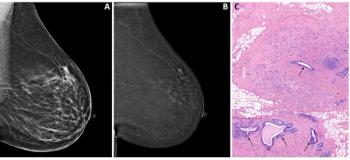
New Technique Plus Conventional Ultrasound Scans Improve Fetal Circulation Pathology Detection
By combining a wave reflection analysis with standard Doppler ultrasound, providers can better identify whether a pregnant woman is experiencing impeded blood flow to the placenta, potentially improving pregnancy outcomes.
Providers can use a new ultrasound technique to more accurately detect blood flow problems in the placenta, potentially leading to an improvement in the diagnosis of fetal pathologies.
Placental problems happen in more than half of the cases of fetal growth restriction (FGR) or stillbirth annually. FGR affects up to 10 percent of pregnancies each year, and it is present in roughly 20 percent of stillbirths. Consequently, being able to effectively detect blood flow problems is critical.
Currently, providers use Doppler ultrasound to assess part of fetal health by measuring the pulsality of the umbilical artery blood velocity waveforms. But, several factors, including the fetal heartbeat can make an accurate examination and determination difficult.
In a study published in
“In this study, we found that wave reflections were larger in women with placental vascular pathology compared to healthy pregnancies,” said the team led by John G. Sled, Ph.D., senior scientist in the Program of Translational Medicine in obstetrics and gynecology department at The Hospital. “This was true for both maternal vascular malperfusion (MVM) and fetal vascular malperfusion (FVM).”
To assess whether using wave reflection analysis with Doppler ultrasound could augment placental pathology diagnosis, the team, funded by the National Institute of Health’s Eunice Kennedy Shriver National Institute of Child Health and Human Development, performed standard clinical ultrasound on 241 women between ages 18 and 45 who were between the 26th and 32nd weeks of pregnancy. Of this group, 36 women had been diagnosed with MVM, 16 had received FVM diagnoses, and 40 were considered healthy controls. The remaining 149 women had non-diagnostic findings or rare placental diagnoses.
Based on their analysis, women with MVM or FVM were significantly more likely to have adverse pregnancy outcomes, such as preeclampsia or small for gestational age births, than were women with no placental pathologies. In addition, women with FVM also had high rates of umbilical cord abnormalities, including entanglement at delivery, small cord diameter (less than 8 mm), and hyper-coiling.
In addition, they found that women with placental vascular pathologies had larger wave reflections than the healthy controls. According to their evaluation, the first harmonic coefficients were elevated in women with MVM and FVM by 55 percent and 41 percent, respectively. These higher coefficients indicated that there was one or more distal site of high hemodynamic impedance and/or a large impedance mismatch, the team said. They suspected the capillaries within the terminal villi because the structure of the villi are abnormal in both MVM and FVM.
With the clinical ultrasound-derived parameters, the team determined the umbilical artery pulsality index was significantly increased by 48 percent over the healthy controls, and the uterine artery pulsality index was increased by 77 percent, and the cerebroplacental ratio was significantly decreased by 35 percent in the MVM group. In addition, FVM women had no significant differences in umbilical or uterine artery pulsality index or the cerebroplacental ratio.
When viewed together, the team said, these findings offer diagnostic benefit.
“The predictive performance of the first harmonic reflection co-efficient was moderate. Combining the wave reflection coefficient with other metrics used clinically for surveillance (i.e., umbilical and uterine artery pulsality index, fetal biometry, and maternal blood testing) has the potential to improve diagnosis of placental pathologies,” they said.
If it is confirmed that a woman has an increased first harmonic wave reflection coefficient, a differential diagnosis can determine whether she had MVM or FVM pathology based upon whether she had an elevated umbilical or uterine pulsality index. Gestational age would then determine the next course of action, such as more intensive fetal monitoring or emergency C-section.
Overall, the team said, these findings are particularly promising for women with FVM because there is no current reliable method for detection.
For more coverage based on industry expert insights and research, subscribe to the Diagnostic Imaging e-Newsletter
Newsletter
Stay at the forefront of radiology with the Diagnostic Imaging newsletter, delivering the latest news, clinical insights, and imaging advancements for today’s radiologists.






























